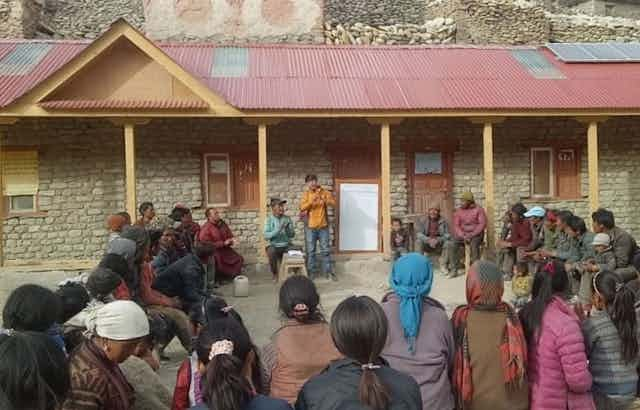In Nepal’s second-largest city, Pokhara, when students’ classes were cancelled due to COVID-19 in March, medical student Gyalsten Gurung, 25, left the city. He returned to Shimen, the remote village where he was born in the Himalaya’s Upper Dolpo region.
There, he taught villagers about good hand hygiene, social distancing and ways to prepare safe water for consumption and cleaning where there is no running water. He also created COVID-19 posters in the local language and engaged elders through whiteboard activities, diagrams and storytelling.
He and two other medical students, who have also led COVID-19 village education, are among 22 Himalayan youth I interviewed as part of my research into youth migration in the Himalayas. All 22 interview participants (13 male youth, nine female) migrated to Kathmandu during the civil war (1996-2006) to avoid recruitment as child soldiers or other concerns related to the war. In addition to these interviews, I have surveyed over 150 youth.

In the past five years, after the 2015 earthquake and up to the time the COVID-19 crisis close schools across Nepal and restricted applications for study or work abroad, these youth have increasingly started to return to their villages from Kathmandu and other cities in Nepal. From cities such as Bhaktapur, Pokhara and Chitwan they are making trips and visits to engage with their communities of birth on important social issues that affect people’s survival and quality of life.
To my knowledge, no data exists that captures the migration of Himalayan youth back to their villages. But in my research I have seen anecdotal evidence that youth are returning and educating their rural communities on a larger scale.
Read more: Learning from disasters: Nepal copes with coronavirus pandemic 5 years after earthquake
Remote realities

Within the Himalayan mountains are some of the most remote villages in the world. These mountains cover about 75 per cent of Nepal, which as a nation has been challenged by slow educational growth. Nepal has one of the youngest education systems internationally.
Yet, there have been more young people migrating from remote mountain villages to other locations within and outside of Nepal, for better educational opportunities.
Youth migrate from the Himalayas for several reasons. Some migrate to pursue non-farming work, for international studies or vocational opportunities, and for religious studies in Buddhist monasteries.
But other factors also play a role: harsh winters keep some schools closed for up to six months a year, and the impacts of climate change and inadequate health care also affect where youth or their families choose or are able to live.

Rural education
Rural Nepalese villagers’ top concerns about education include the fact that students sometimes walk for hours to the closest or sole school in the region.
Existing schools are often poorly constructed, unhealthy and dangerous. Also, many provide only basic primary education.
The quality of education in Himalayan regions is even more challenged compared to other rural areas of Nepal. For example, the mountain regions have the highest proportion (24.3 per cent) of four-year-olds not attending school and often face staff and resource shortages.
Also, due to mountainous terrain and insufficient government funding, the Himalayan regions have poor-quality or no internet, phone and computer services, and minimal training on using existing technologies for education.

Students as teachers
Building on my earlier research on relationships between youth migration, emotions and long-term family separation caused during Nepal’s civil war, my current PhD research examines transitions of Himalayan young people into higher education and work in Nepal or abroad, and return visits to their villages.
I have found that returning students taught villagers about various topics through different creative methods that encouraged villagers’ active engagement.

Addressing inequalities
Among students who participated in my interviews, a group of Himalayan students directly helped (or provided educational knowledge) towards the establishment of an NGO in Kathmandu. The NGO assisted with arts-based community development for students in rural Himalayan villages. It addresses concerns such as access to rural health care, gender inequality, child marriage and labour and caste discrimination. In various Nepali and Tibetan-based languages, in their villages of birth, the students wrote songs so that their communities could better understand their social messages.

Preserving Indigenous culture
Science student Binod Gurung, 21, studying in Chitwan, the city famous for Nepal’s first protected national park, with other students returned to Manang, the district with the smallest population growth and lowest population density in Nepal. These students sought to stress land-based learning.
The group focused on preserving Manang’s Indigenous Himalayan culture. Students taught community members effective hygiene practices and how to use cameras to track wildlife and scientific instruments to measure different components of the lake. They also led a land-based drama that served to support the the community in further linking ancestral histories to scientific learning.

Moving forward
These students are contributing to rural educational development throughout the Himalayas by offering their own urban educational experiences in ways that help meet and bridge rural concerns. However, these returning youth, alone, cannot change rural education systems.
Youth in my study expressed that holding the government accountable for rural educational development and also pushing for increased local NGO and INGO funding collaboration is needed for greater positive change.
Also, they advocated for the idea that both rural and urban educational systems should train educators and health-care workers how to use different methods for teaching important topics in rural settings to different social groups. Doing so would expand inclusion for better systemic education for a larger number of children and would include more educators in better training to teach in rural environments.
Lastly, youth expressed the need for more active participation of return migrants themselves. They want to contribute their knowledge gained while studying in cities outside of the Himalayas to help further positive educational changes in remote Himalayan regions of Nepal.

